Saturday 14 September 2013, Batumi
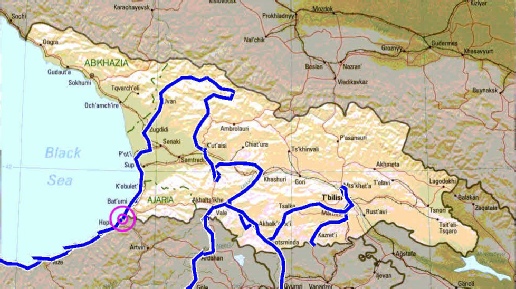 A snack of tender beef stew, bead and tea in Turkey kept our lunchtime hunger at
bay while we went through the border. The queue was long and confusing. There is
no space on the Turkish side. The trucks took one lane and backed up through the
tunnels. The other lane moved slowly. To go through the border cars had to go around,
do a U turn on the one way road and queue up to return to the border going in the
opposite direction to the traffic! The borders themselves were relatively fast.
A snack of tender beef stew, bead and tea in Turkey kept our lunchtime hunger at
bay while we went through the border. The queue was long and confusing. There is
no space on the Turkish side. The trucks took one lane and backed up through the
tunnels. The other lane moved slowly. To go through the border cars had to go around,
do a U turn on the one way road and queue up to return to the border going in the
opposite direction to the traffic! The borders themselves were relatively fast.
Before the border there are still many small businesses selling clothes and bedding. Georgians buy these to sell back in Georgia. The same like the last time we came through in 2007. Some things have changed. Most of the abandoned buildings have disappeared. There are lots of new houses or signs of renovation or maintenance. Corrugated iron is still in use for outside walls and rooves though. Technology meets the third world in Georgia. Cell phones are everywhere. The old man on his horse and cart has one. The lone herder in the hills has one. Of course the Yuppie in the town also has one. The driving is bad. Cars either go too slow or too fast, then they either don’t overtake or wait until it is dangerous to overtake before doing so. The license plates use western script and numbers. Georgian script would be unreadable in the rest of the world.
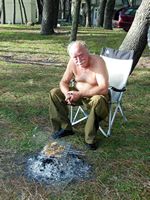
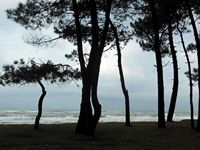
We found a nice quiet spot by the Black sea for the first braai in a long time and good nights sleep.
Sunday 15 to Monday 16 September 2013, Mestia
When ever I think of Georgia I will think of the colour Black. Black hair, black clothes, black silt coming from black rocks and rushing down rivers to the black sea. The mountains are mostly black rock and the rivers are grey with the silt.
The road to Mestia was tarred and generally good, although work was still being done
on widening it in places and removing parts of the mountain side to prevent rock
slides. Mestia is a pleasant town and definitely on the tour bus route. If tourists
wanted to go further they had to take a local bus. Eventually an improved road to
Ushguli will be finished but it will take years. Tourists mean decent coffee. The
Georgian food does not have much variety. It mainly consists of bread and meat. The
flat bread can be plain or cooked with a filling of cheese, beans or meat. When the
meat is bar-
Besides the spectacular scenery the reason to come to Mestia, high in the Caucasus,
is to see the Svan defensive towers. Each family, which could consist of 30 or more
people, built 1 or more towers inside a thick wall. For protection, the entrance
to the tower was some twelve feet above the ground, with a ladder below that could
be destroyed in the event of an attack. Inside, large, flat rocks lay beside the
ladder holes, ready to be used as seals. There was also a house attached to the tower
and other out-
The statue of Queen Tamara (1160 to 1213) is interesting. She is one of the venerated leaders of Georgia. She was an only child of King George III and ruled with her father for 5 years and crowned at 18. Her claim to fame is repulsing Muslim armies attacking Georgia. During her reign Georgia became known as the Defender of the Caucasus.
Tuesday 24 to Thursday 26 September 2013, Vardzia
Another foray through the mountains! Our next destination was Vardzia. There appeared to be two ways of getting there from Kutaisi. One via the main road and another via the mountains. The road via the mountains was on the tourist information maps and on Google Maps. The road was even on the Garmin map which is anything but accurate beyond Western Europe. Seemed good. The mountain road joined the main road at Akhaltsikhe some 100 or so kilometers away. It turned out to be a roller coaster ride through pools of water and slip sliding through quagmires of mud. We followed recent tyre tracks over patches of mud fortified with branches and a concrete bridge that had come away from one side of the ravine and been repaired with thick branches. Eventually the tyre tracks disappeared and the old track could hardly be seen through the grass. It was still on the GPS though. We went on until the huge rock slide before acknowledging that we would have to retrace our route, something Pieter always likes to avoid. There were a few houses along the way and cows, presumably at their summer pasture. The scenery was great.
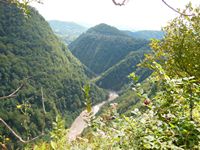
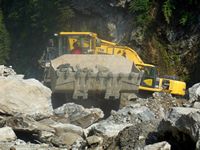
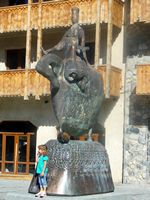
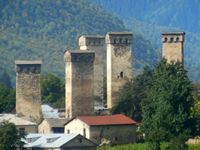
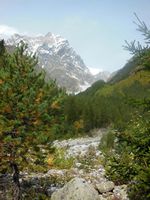
Tuesday 17 to Wednesday 18 September 2013, to Kutaisi
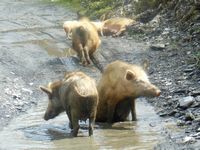
Leaving Mestia we took the road to the nearby glacier, then to the ski station. Finally we found the right road to Ushguli. The road is being widened and eventually tarred. At least they have made a start. Personally I think it will take years. There is a lot of bridge building, mountain removal and reinforcing to be done. The scenery is fabulous. The road winds up and down mountains, through valleys, villages and gates. The road wasn’t too bad, around 20kph.
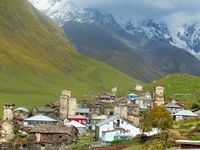
We arrived in Ushguli for a late lunch but had to wait as the cafe was very busy feeding day trippers from Mestia. We decided to move on and found a good spot to camp for the night.
The road deteriorated after Ushguli, much to Pieter’s delight. Our speed varied from
5 to 20 kph. We caught up with a Toyota stuck in a mud slide. The mud covered about
3 metres of road but was over a metre thick in the middle. There were 2 cars with
Yoshi and Le-
There followed several attempts to free the car. They couldn’t manage with our steel
rope. Some of the mud was dug away from the front tyres. Pieter changed places as
our Toyota was stronger. This time the steel rope broke. They tried with a sand ladder
under one of the front (drive) wheels, with Pieter pushing the car with a branch
(it broke) then with the high lift jack ( a new use for it). By this time a tour
group of 6 4X4s had arrived. They had a new tow rope but nothing else. Lots of manpower
to the rescue. They all got together and tried to pull the car out using man-
Pieter drove over the mud first and the other 8 cars followed. The road from then on was passable with one last river to cross.
The tour group were left far behind. They had to wait for everyone to go across obstacles before moving on. Obviously some inexperienced 4X4ers. The 6 of us spent the night talking, eating and sleeping in Ysageri in a private home. It had been a great adventure with wonderful people.
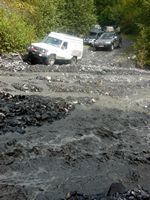
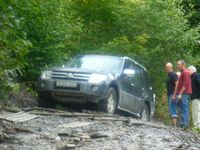
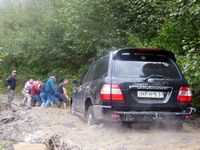
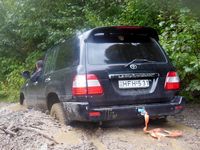
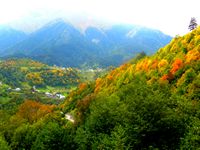
Thursday 19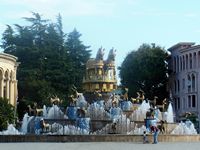 to Monday 23 September 2013, Kutaisi
to Monday 23 September 2013, Kutaisi
Time spent doing some financial admin that demanded attention. Got to keep the money rolling in.
We met a British couple who had tried to go to Ushguli from Ysageri on Saturday with their motor bike. There had been so much rain that the road was impassable. It had already snowed in Ushguli last Wednesday so I guess that is it for the season. We went just in time.
Vardzia is a cave town built by King George III in 1156-
Pieter relaxed while I went up to look. There are still monks living in a section of the caves and a church with frescos. Most of the caves now have lost their outside walls and are separated from each other. Still, I enjoy exploring such sights.
Friday 27 to Saturday 28 September 2013, Mtskheta
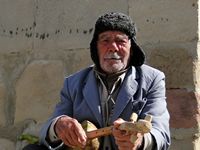 A lovely serene small old town. We asked for hotel but were told there was none but
a room in a home in the old town was available. It was totally unsuitable for us.
The bedrooms were on the second floor and the toilet in the basement. Not good for
middle of the night forays. Heading out again we noticed a hotel sign right opposite
the Svetitskhoveli Cathedral. It had an on suite, much better.
A lovely serene small old town. We asked for hotel but were told there was none but
a room in a home in the old town was available. It was totally unsuitable for us.
The bedrooms were on the second floor and the toilet in the basement. Not good for
middle of the night forays. Heading out again we noticed a hotel sign right opposite
the Svetitskhoveli Cathedral. It had an on suite, much better.
Mtskheta has been inhabited since 1,000 BC, It was a major trading post on the Silk Road and the capital of an early kingdom, Iberia, current Eastern Georgia, until the capital was moved to Tbilisi in the 6th century. It has been the religious centre since Georgia converted to Christianity around 337 AD.
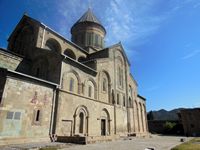
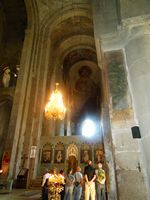
The cathedral has been renovated over the centuries. Alexander the Great had a hand in this. He restored the western section between 1413 and 1430. Several kings, patriarchs and nobles are buried in the cathedral. It is relatively plain but has a very high roof.
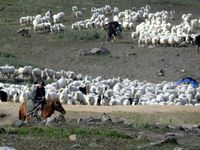
While driving through Tbilisi we noticed a number of modern buildings. We prefer the country side.
The last part of the road to Armenia is bad near border which is very quiet.
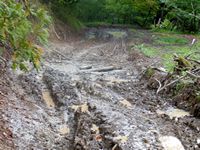
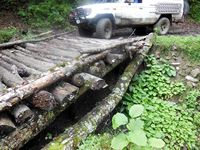
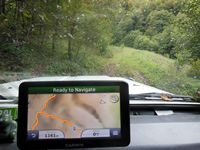
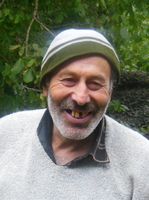
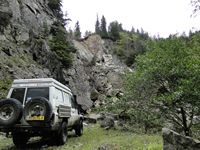
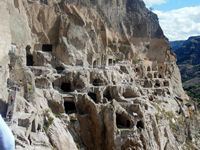
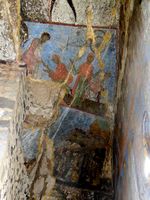
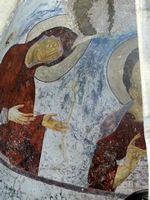
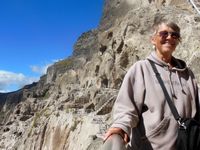
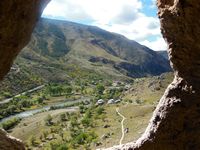 Back to Turkey
Next to Armenia
Back to Turkey
Next to Armenia
|
Averages |
Euro |
|
Cost of diesel per litre |
0.75 |
|
Cost of Camping per night |
|
|
Cost of Hotels per night |
30.44 |
|
Daily expenditure |
49.15 |
|
Totals |
|
|
Kilometers travelled |
1,363 |
|
Days in country |
16 |


